Rapanea melanophloeos
Rapanea melanophloeos (L.) Mez
Family: Myrsinaceae
Common names: Cape Beech (Eng.); Boekenhout, Beukehout (Afr.); IsiCalabi, umaPhipha, iKhubalwane, isiQalaba sehlati (Zulu); isiQwane sehlati (Xhosa); iGcolo, udzilidzili (Sw)
SA Tree No: 578
Introduction
The graceful Cape Beech is a hardy tree for a large, coastal garden setting, and for windy areas.

Description
Description
This is an evergreen tree, 4-18 m high. The mature leaves are leathery and dull, dark green, paler below. They are simple, oblong-lanceolate, about 100 mm long, have reddish leaf stalks are and clustered mainly at the end of the branches. When young, leaves are pale green and maroon.
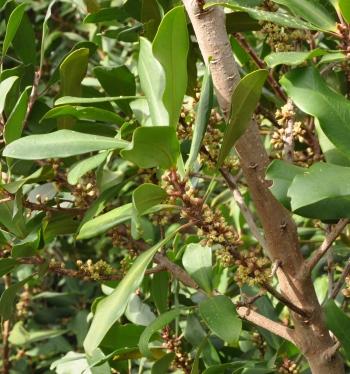
Small, whitish or creamy yellow clusters of flowers appear on the branchlets in winter, spring and early summer (June to December).
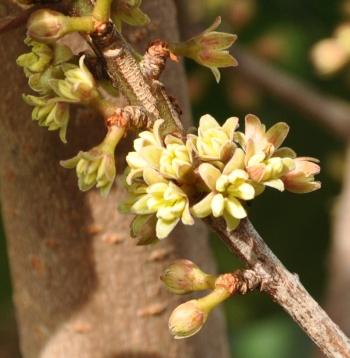
The fruits are thinly fleshed and spherical in shape, green when young and purple when matured.
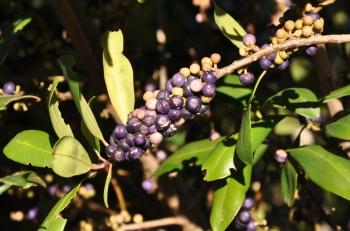
It is not uncommon to find flowers and fruit on the same tree. Fruits start appearing three months after the flowers.
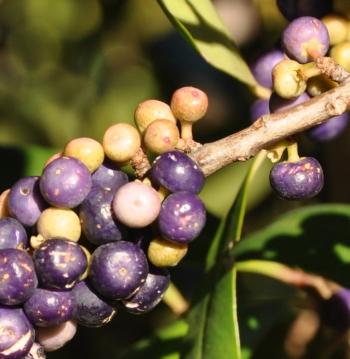
Conservation Status
Status
Rapanea melanophloes is not threatened or endangered; this is attributed to its wide distribution.
Distribution and habitat
Distribution description
The Cape Beech is widely distributed throughout southern Africa from the Western Cape to Zambia, and the east coast to the tropics. It is found along the damp areas of mountain and coastal forests or swamps and bush clumps. The Cape beech does well in coastal areas where winds are strong; it is fairly drought-tolerant.
Rapanea melanophloes and R. gilliana (Dwarf Cape Beech) are the two known species of Rapanea in South Africa. Occurring in coastal dune scrub in the Eastern Cape, R. gilliana is a shrub or small tree to 4 m.
Derivation of name and historical aspects
History
It is surmised that the name Rapanea is derived from the Guinean name. The specific name melanophloeos can be interpreted as 'dark bark', but this is only the case in older specimens.
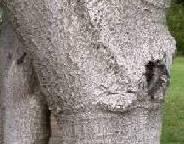
The Cape Beech is not related to the European Beech, but earned this name because the grain of its wood looks similar to that of the European Beech. Another South African boekenhout are the Faurea species, which are also not related to the true Beech. The Xhosa name isiQwane sehlati, which means 'Protea of the forest', and describes the protea-like cluster of the leathery leaves at the end of the branches.
Ecology
Ecology
The flowers attract bees and flies, and the fruit is eaten birds, baboons, vervet monkeys, and bushpig.
Uses
Use
The wood is hard and used to make furniture and violins.
The grey bark and sometimes the roots are used medicinally for respiratory problems, stomach, muscular and heart complaints. The bark contains tannin and is used as iNtelezi (a charm to protect against evil spirits) by Nguni people.

Growing Rapanea melanophloeos
Grow
It can be used as a hardy screening plant, as it is dense, evergreen and sends out suckers to form bush clumps. It requires low maintenance, if planted in the right area, and is better not planted next to paved areas because roots and new suckers can sprout and damage the paving.
Rapanea melanophloeos grows easily from seed sown in spring or early summer. Sow seeds in a well-drained, general-mix, potting soil, placed in a warm, moist, shaded area. Treatment of seed with fungicide will prevent damping off and increase the percentage germination.
References
- Coates Palgrave, K. 1977. Trees of southern Africa, edn 2. Struik, Cape Town.
- Palmer, E. & Pitman, N. 1972. Trees of southern Africa. Balkema, Cape Town.
- Pooley, E. 1993. The complete field guide to trees of Natal, Zululand and Transkei. Natal Flora Publication Trust, Durban.
- Smith, C.A. 1966. Common names of South African plants. Memoirs of the Botanical Survey of South Africa No. 35. Government Printer, Pretoria.
- Van Wyk, B. & Van Wyk, P. 1997. Field guide to trees of southern Africa. Struik, Cape Town.
- Van Wyk, B.E., van Oudtshoorn, B., Gericke, N., 1997, Medicinal Plants of South Africa, Briza Publications, Pretoria.
Credits
Phakamani m'Afrika Xaba
Harold Porter National Botanical Garden
April 2005
Plant Attributes:
Plant Type: Tree
SA Distribution: Eastern Cape, KwaZulu-Natal, Limpopo, Mpumalanga, Western Cape
Soil type: Sandy, Loam
Flowering season: Spring, Early Summer, Winter
PH: Acid, Neutral
Flower colour: Cream
Aspect: Full Sun, Morning Sun (Semi Shade), Afternoon Sun (Semi Shade)
Gardening skill: Average
Special Features:
Horticultural zones









Rate this article
Article well written and informative
Rate this plant
Is this an interesting plant?
Login to add your Comment
Back to topNot registered yet? Click here to register.